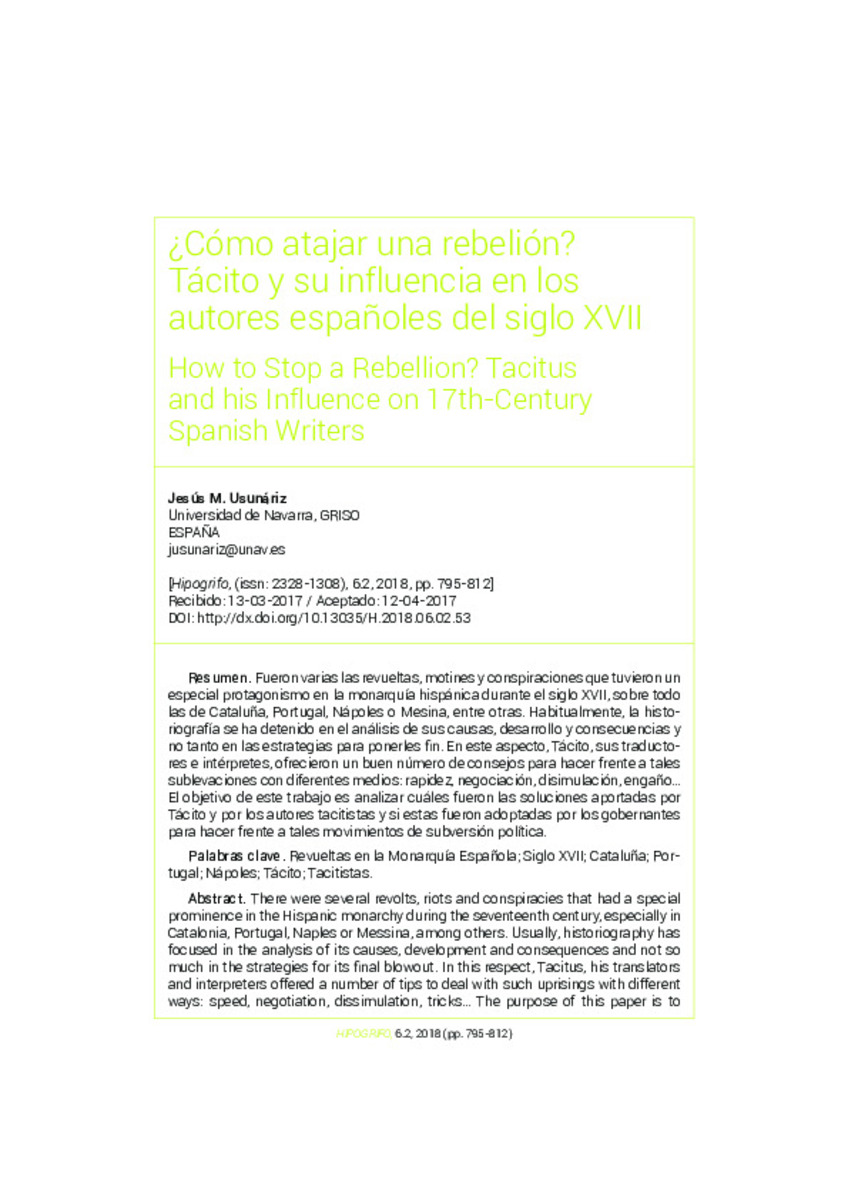Full metadata record
| DC Field | Value | Language |
|---|---|---|
| dc.creator | Usunáriz, J.M. (Jesús María) | - |
| dc.date.accessioned | 2022-10-19T08:01:24Z | - |
| dc.date.available | 2022-10-19T08:01:24Z | - |
| dc.date.issued | 2018 | - |
| dc.identifier.citation | Usunáriz, J.M. (Jesús María). "¿Cómo atajar una rebelión? Tácito y su influencia en los autores españoles del siglo XVII". Hipogrifo. 6 (2), 2018, 795 - 812 | es |
| dc.identifier.issn | 2328-1308 | - |
| dc.identifier.uri | https://hdl.handle.net/10171/64492 | - |
| dc.description.abstract | Fueron varias las revueltas, motines y conspiraciones que tuvieron un especial protagonismo en la monarquía hispánica durante el siglo XVII, sobre todo las de Cataluña, Portugal, Nápoles o Mesina, entre otras. Habitualmente, la historiografía se ha detenido en el análisis de sus causas, desarrollo y consecuencias y no tanto en las estrategias para ponerles fin. En este aspecto, Tácito, sus traductores e intérpretes, ofrecieron un buen número de consejos para hacer frente a tales sublevaciones con diferentes medios: rapidez, negociación, disimulación, engaño… El objetivo de este trabajo es analizar cuáles fueron las soluciones aportadas por Tácito y por los autores tacitistas y si estas fueron adoptadas por los gobernantes para hacer frente a tales movimientos de subversión política. | es_ES |
| dc.description.abstract | There were several revolts, riots and conspiracies that had a special prominence in the Hispanic monarchy during the seventeenth century, especially in Catalonia, Portugal, Naples or Messina, among others. Usually, historiography has focused in the analysis of its causes, development and consequences and not so much in the strategies for its final blowout. In this respect, Tacitus, his translators and interpreters offered a number of tips to deal with such uprisings with different ways: speed, negotiation, dissimulation, tricks… The purpose of this paper is to analyze the solutions provided by Tacitus and the Tacitian authors and if these solutions were adopted by the rulers to deal with such political subversion movements. | es_ES |
| dc.language.iso | spa | es_ES |
| dc.publisher | Instituto de estudios auriseculares | es_ES |
| dc.rights | info:eu-repo/semantics/openAccess | es_ES |
| dc.subject | Revueltas en la Monarquía Española | es_ES |
| dc.subject | Siglo XVII | es_ES |
| dc.subject | Cataluña | es_ES |
| dc.subject | Portugal | es_ES |
| dc.subject | Nápoles | es_ES |
| dc.subject | Tácito | es_ES |
| dc.subject | Tacitistas | es_ES |
| dc.subject | Revolts in the Spanish Monarchy | es_ES |
| dc.subject | XVIIth century | es_ES |
| dc.subject | Catalonia | es_ES |
| dc.subject | Portugal | es_ES |
| dc.subject | Naples | es_ES |
| dc.subject | Tactitus | es_ES |
| dc.subject | Tacitian authors | es_ES |
| dc.title | ¿Cómo atajar una rebelión? Tácito y su influencia en los autores españoles del siglo XVII | es_ES |
| dc.title.alternative | How to stop a rebellion? Tacitus and his influence on 17th-century spanish writers | es_ES |
| dc.type | info:eu-repo/semantics/article | es_ES |
| dc.description.note | Hipogrifo (ISSN: 2328-1308) es una revista bajo una Licencia Creative Commons Atribución-NoComercial-SinDerivadas 3.0 | es_ES |
| dc.identifier.doi | 10.13035/H.2018.06.02.53 | - |
| dadun.citation.endingPage | 812 | es_ES |
| dadun.citation.number | 2 | es_ES |
| dadun.citation.publicationName | Hipogrifo | es_ES |
| dadun.citation.startingPage | 795 | es_ES |
| dadun.citation.volume | 6 | es_ES |
Files in This Item:
Statistics and impact
Items in Dadun are protected by copyright, with all rights reserved, unless otherwise indicated.






